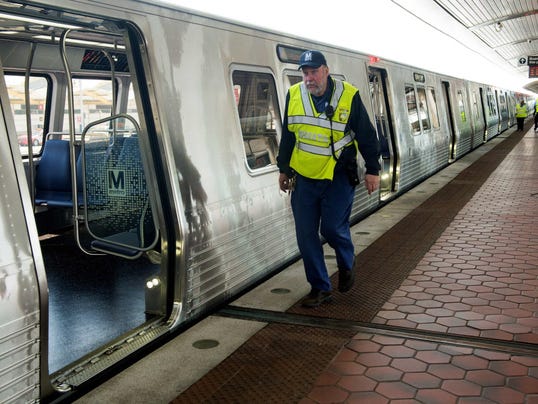
A Washington Metropolitan Area Transit Authority worker walks past a new 7000 series subway car on April 13, 2015. Metro is accepting delivery of 20 of the cars a month to replace aging trains. (Photo: PAUL J. RICHARDS, AFP/Getty Images)
WASHINGTON – The head of the city’s beleaguered Metro system, the second-largest in the country, said Wednesday that the pace of replacing cars has more than doubled in the past year and intense track repairs that close stations for weeks should end by June.
Paul Wiedefeld, general manager and CEO of the Washington Metropolitan Area Transit Authority (WMATA), told the National Press Club that an improved safety culture began taking root in March — when the subway shut down for a blizzard — after years of deterioration.
Workers are restoring the 40-year-old system with 700,000 daily riders to “good” condition before trying to return to the “greatness” of its early years, Wiedefeld said.
“We have a very long way to go to turn Metro around, but I know we are on the rise,” Wiedefeld said on his first anniversary leading the system.

USA TODAY
Major repairs and major delays for DC Metro to begin in June
Metro is in the midst of a year-long maintenance program that comes after severe criticism of the subway's damaged equipment. One passenger died and 90 other people were taken to hospitals after smoke filled a subway tunnel in January 2015. A similar fire in the McPherson Square station in March prompted a one-day closure of the entire system for inspections and emergency repairs.
The SafeTrack repair program, which aims to condense three years of work into one year, began in June. The program features 15 “surges” where service is reduced and stations are shut down in order to lengthen time available for repairs. A Federal Transit Administration review found 130 defects during the first three surges.
When the SafeTrack program ends in June, the above-ground system will be in good repair for the first time in a decade, Wiedefeld said.
Moisture in the underground system, which corrodes power lines along a portion of the Red line, remains a problem. But Wiedefeld’s goal is to reduce unplanned track delays by 50%, he said.
“It is amazing to me to see the transformation out there on the system,” he said.
Metro is also accelerating the replacement of subway cars. Metro is now accepting delivery of 20 of the new 7000-model cars each month, up from eight cars per month a year ago, Wiedefeld said.
Metro has 27 full trains of the new cars in service, he said. All eight-car trains will feature the new cars by the end of 2017, he said.
“Obviously they’re a much better product,” Wiedefeld said. “It deals with lighting. It deals with the communications system.”
Metro is launching a new system for passengers to rate the service in surveys in terms of reliability, customer service and personal safety. The system is now scoring 60, 79 and 70 in the three categories, which Wiedefeld said will be used to gauge improvement.
“We’ll measure our progress the same way that customers measure their experience,” he said.
The House Oversight subcommittee on transportation is holding a hearing Friday about WMATA’s maintenance program. The hearing will feature Wiedefeld, WMATA Chairman Jack Evans, National Transportation Safety Board Chairman Christopher Hart and FTA Executive Director Mathew Welbes.
Other goals during the next year include:
• Thoroughly cleaning all 91 stations annually, rather than the current pace of once every four years.
• Replacing the public-address system for better communications.
• Expanding cellphone access in areas where it is weak.
“We’ll continue to chip away at that issue for our customers,” Wiedefeld said.

USA TODAY
Investigators: D.C. Metro ignored safety provisions for years
Không có nhận xét nào:
Đăng nhận xét